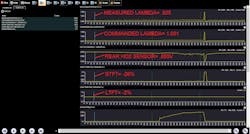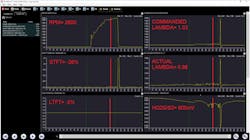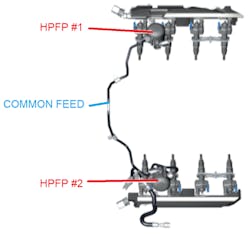Content brought to you by Motor Age. To subscribe, click here.
Welcome back to another edition of “The data doesn’t lie,” a regular feature in which I pose a puzzling case study, followed by the answers to the previous issue’s puzzle.
What You Will Learn:
• Data driven diagnostics ensures fixing the root cause of a symptom
• Understanding their strategies at play aids in diagnosis
• Comparing the rear HO2 sensor signal to the primary signal can help corroborate a story
Very similar to last month’s theme, I was providing technical assistance for a driveability complaint for a GDI platform. The vehicle was a 2019 Honda Fit with a 1.5L engine. The original complaint was for the only exhibited symptom, a DTC P0172- “system rich.”
Preliminary data
After viewing some basic scan data uploaded to ShopStream Connect from a Snap-on Zeus, it’s clear to see that both the front and rear heated exhaust gas oxygen sensors (HEGOs) are telling the same story: the exhaust stream is oxygen-deficient (rich). With a measured lambda value of .925, the exhaust contents measure almost 9 percent too rich of the commanded stoichiometric Lambda value of 1.00 (Figure 1). As a result, the PCM is trying hard to regain control by negating total fuel trim by approximately 28 percent. So, as always, the question becomes “why?”
Never leaving the driver’s seat unless I need to is the secret to my success and efficiency. One can obtain many answers simply by asking the correct questions. Idling engines should breathe approximately 1.5 times their displacement (in liters), which is reflected in grams per second (gps).
According to the data, at idle this engine is pumping 2.4 gps (Figure 2). According to the formula, that is almost spot-on. It should be clear that the MAF sensor is reporting correctly and is not the cause of the 28 percent surplus of fuel delivery.
The next logical test was to raise the rpm to change the operating conditions. The results of this quick test would quickly flush out a fault like a leaking EVAP purge valve or even a dripping injector. The increase in fuel demand from this test would actually require additional fuel. In those examples just given, we would expect fuel trim to begin to normalize when the engine was loaded. However, that is not the case here. The heavily negated trim was present under all operating conditions (Figure 3). This leaves only several potential causes (and we haven’t even left the driver’s seat yet!).
Easy tests first
As mentioned, only several possibilities can cause a rich condition under all operating ranges. The engine oil was inspected for a high level /odor (which would indicate an internal fuel leak from the high-pressure fuel pump). Fuel vapors from fuel-contaminated oil will be ingested by the PCV system and will cause negative fuel trim. Though this trim tends to negate mostly under high-vacuum/low-load conditions, it is certainly an easy item to check; no fault was found. A fuel sample was then taken to see if the tank contained any contaminants. Only gasoline with an ethanol content of 10 percent was found.
At this point, many of the potentially faulted items have been eliminated. Which direction you head in and the next subsequent test to be performed varies, mainly due to the vehicle and/or scan tool software. Some scan tools/vehicle software allow for some very accurate automated component testing, but others do not.
The data doesn’t lie
With all the information in front of us, we are faced with deciding how to proceed. Here are some bullet points of what we know to be factual, and I will ask all of you diligent readers for your input:
- Vehicle flags DTC P0172
- Scan data shows that the vehicle is rich (with negative fuel trims) under all conditions
- Scan data shows that the MAF (main input for fueling strategy) is reporting accurately
- Neither the fuel nor engine oil are contaminated
Given this information, what would you do next?
- Replace skewed primary WRAF sensor
- Perform available direct injector automated scan tool test
- Replace all four direct injectors
- Replace skewed-high fuel rail pressure sensor
SOLVED: (June 2023, Motor Age) 2014 BMW X6, lean condition
What would you recommend doing next, given the data bullet points in last month’s challenge?
- Gather more information about the commanded rail pressure and low-pressure fuel delivery system
- Replace in-tank low-pressure fuel supply pump
- Replace GDI fuel injectors
- Replace both high-pressure fuel pumps
For those of you who chose answer #1, congratulations. Although faulty high-pressure fuel pumps will cause similar symptoms, answer #4 would make sense, but these pumps cannot generate the pressure necessary without adequate supply from the low-pressure side of the fuel system. GDI injectors can most certainly create lean conditions, making answer #3 plausible, but they wouldn’t cause a significant drop in rail pressure under sustained load. We simply cannot condemn any high-pressure fuel system components without first verifying the integrity and performance of the low-pressure fuel system (Figure 4). Replacing the low-pressure (in-tank) fuel pump is logical, as it is common to both banks (just like the fault), making answer #2 likely. But any good technician tests and doesn’t guess. The best answer is answer #1.
There was no fix as the customer decided not to pursue the fault any further. It’s unfortunate, as I always like to prove my cases by demonstrating the capture of post-repair data. However, it is the approach that is important. Using the collected data directs us where to focus our testing efforts next. With that mindset, almost anything can be diagnosed correctly.
Be sure to read September's Motor Age issue for the answer to this month’s challenge and what was discovered!
About the Author
Brandon Steckler
Technical Editor | Motor Age
Brandon began his career in Northampton County Community College in Bethlehem, Pennsylvania, where he was a student of GM’s Automotive Service Educational program. In 2001, he graduated top of his class and earned the GM Leadership award for his efforts. He later began working as a technician at a Saturn dealership in Reading, Pennsylvania, where he quickly attained Master Technician status. He later transitioned to working with Hondas, where he aggressively worked to attain another Master Technician status.
Always having a passion for a full understanding of system/component functionality, he rapidly earned a reputation for deciphering strange failures at an efficient pace and became known as an information specialist among the staff and peers at the dealership. In search of new challenges, he transitioned away from the dealership and to the independent world, where he specialized in diagnostics and driveability.
Today, he is an instructor with both Carquest Technical Institute and Worldpac Training Institute. Along with beta testing for Automotive Test Solutions, he develops curriculum/submits case studies for educational purposes. Through Steckler Automotive Technical Services, LLC., Brandon also provides telephone and live technical support, as well as private training, for technicians all across the world.
Brandon holds ASE certifications A1-A9 as well as C1 (Service Consultant). He is certified as an Advanced Level Specialist in L1 (Advanced Engine Performance), L2 (Advanced Diesel Engine Performance), L3 (Hybrid/EV Specialist), L4 (ADAS) and xEV-Level 2 (Technician electrical safety).
He contributes weekly to Facebook automotive chat groups, has authored several books and classes, and truly enjoys traveling across the globe to help other technicians attain a level of understanding that will serve them well throughout their careers.





